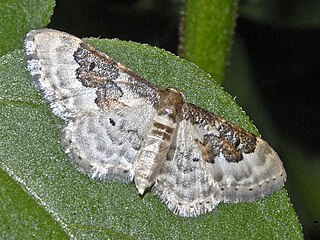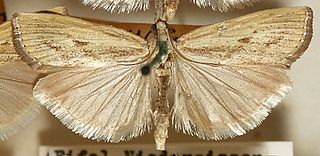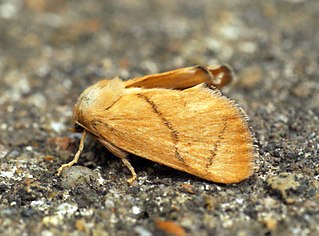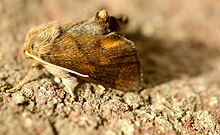
Nepticulidae is a family of very small moths with a worldwide distribution. They are characterised by eyecaps over the eyes. These pigmy moths or midget moths, as they are commonly known, include the smallest of all living moths, with a wingspan that can be as little as 3 mm in the case of the European pigmy sorrel moth, but more usually 3.5–10 mm. The wings of adult moths are narrow and lanceolate, sometimes with metallic markings, and with the venation very simplified compared to most other moths.

Incurvariidae is a family of small primitive monotrysian moths in the order Lepidoptera. There are twelve genera recognised. Many species are leaf miners and much is known of their host plants, excluding Paraclemensia acerifoliella. The most familiar species in Europe are perhaps Incurvaria masculella and Phylloporia bistrigella. The narrow wings are held tightly along the body at rest and some species have very long antennae.

Abraxas sylvata, the clouded magpie, is a Palearctic moth of the family Geometridae that was named by Giovanni Antonio Scopoli in 1763.

Idaea rusticata, the least carpet, is a moth of the family Geometridae. The species was first described by Michael Denis and Ignaz Schiffermüller in 1775.

Horisme vitalbata, the small waved umber, is a moth of the family Geometridae. The species was first described by Michael Denis and Ignaz Schiffermüller in 1775. It occurs in Europe.

Yponomeuta malinellus, the apple ermine, is a moth of the family Yponomeutidae. It is native to Europe and Asia, and it has spread to North America.

Agriphila inquinatella is a small moth species of the family Crambidae. It is found in Europe, around the Caucasus area to Turkestan, and in the Near East to Jordan. The type locality is in Austria.

Agriphila tristella, the common grass-veneer, is a species of moth of the family Crambidae found in Europe and Asia.

Chilo phragmitella is a species of moth of the family Crambidae, sometimes referred to by the vernacular names wainscot veneer or reed veneer. It was first described by Jacob Hübner between 1805 and 1810 as Tinea phragmitella, and is the type species of the genus Chilo.

Duponchelia fovealis is a species of moth of the family Crambidae described by Philipp Christoph Zeller in 1847. It is endemic to the area surrounding the Mediterranean Sea, and the Canary Islands, but has extended its range to other parts of Africa, Europe, the Middle East and North America.

Utetheisa pulchella, the crimson-speckled flunkey, crimson-speckled footman, or crimson-speckled moth, is a moth of the family Erebidae. The species was first described by Carl Linnaeus in his 1758 10th edition of Systema Naturae.

Phyllonorycter maestingella is a moth of the family Gracillariidae. It is found in Europe, Russia and British Columbia, Canada.

Tebenna micalis, also known as the small thistle moth, is a species of moth in the family Choreutidae found worldwide. It was first described by the German Bohemian entomologist, Joseph Johann Mann in 1857.

Micropterix aruncella is a species of moth belonging to the family Micropterigidae, which is distributed throughout Europe. The imago was first described by Giovanni Antonio Scopoli in 1763. This species is one of the best known members of the family, being found in a wide range of habitats from sea level to over 2,000 metres (6,600 ft); the only habitat not favoured by this species is dense woodland.

Eriocrania salopiella is a moth of the family Eriocraniidae and is found in Europe. It was described by the English entomologist, Henry Tibbats Stainton in 1854. The larvae mine the leaves of birch.

Eriocrania chrysolepidella is a moth of the family Eriocraniidae found in Europe. It was first described by the German entomologist, Philipp Christoph Zeller in 1851. The larvae mine the leaves of hazel and hornbeam.

Ancylis diminutana, the small festooned roller, is a moth of the family Tortricidae. It was described by Adrian Hardy Haworth in 1811. In Europe, it has been recorded from Great Britain, Ireland, the Benelux, Scandinavia, the Baltic region, Russia, Poland, the Czech Republic, Hungary, Romania, Slovenia and Switzerland. It is also found in North America.

Ancylis geminana, the festooned roller, is a moth of the family Tortricidae. It was described by Edward Donovan in 1806. It is found in most of Europe and has also been recorded from North America. The habitat consists of fens, marshes and damp heathland.

Apoda is a genus of slug caterpillar moths in the family Limacodidae. There are about 10 described species in Apoda.




















